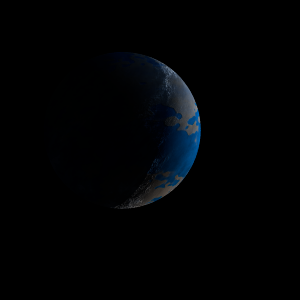|
|
Space Astro
|
Info for exoplanet "Rine Kuzuf"
| Scientific (actual) data |
|---|
| Name | K2-352 c |
| Planet status | Confirmed |
| Radius | 0.196 |
| Orbital period | 14.87 |
| Discovered | 2018 |
| Updated | 2022-11-09 |
| Publication | Published in a refereed paper |
| Detection type | Primary Transit |
| Radius measurement type | Primary Transit |
| Alternate names | EPIC 251319382 c |
| Star name | K2-352 |
| Right ascension | 140.45° |
| Declination | 18.47° |
| Mag v | 11 |
| Wikipedia article | K2-352 c |
Back
| |
| Fictional info (?) |
|---|
| Suggested name | Rine Kuzuf |
| Planet type | Cold planet |
| As seen from K2-352, in a frame of reference that rotates with the orbital motion, it appears to rotate only once every two years.
The polar regions are constantly below 108°K (-165°C).
Because of its rapid rotation, the planet's shape is that of an oblate spheroid (it has a slight but noticeable bulge around the equator). A prominent result is the "great white spot", a giant storm that is known to have existed for centuries since it was first seen by telescope. |
| Atmosphere | Formaldehyde | 97% |
| Ethane | 2.3% |
| Hydrogen | 0.0072% |
| Atmospheric pressure | 50 bar |
 |
| Moon | Ewex | Medium-sized potato shaped rocky comet |
| Eqed | Large round oceanic comet |
| Google search for Rine kuzuf |
|
Website by Joachim Michaelis
|
|
|
|